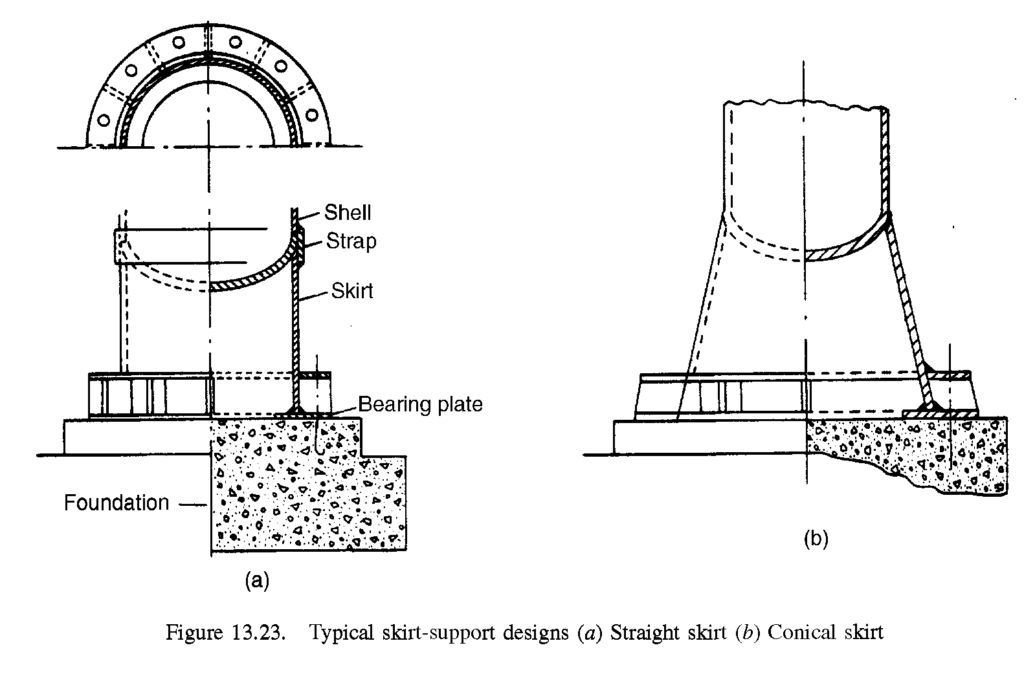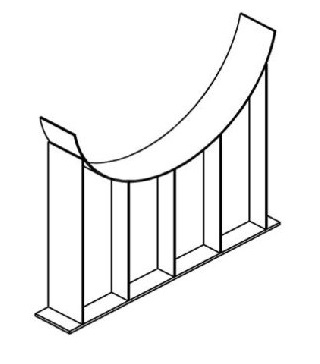Type of supports to be provided to a vessel depend upon its configuration, height to diameter ratio of the vessel, convenience of location, operating temperature and materials of construction.
INTRODUCTION
The attachment of support at suitable location helps to transfer the load from the vessel to support safely. Cylindrical vessels can be installed either in vertical position or horizontal position and the types of supports for such installations are different. Similarly, for spherical vessels, the types of supports required vary considerably as compared to cylindrical vessels. It is necessary to analyze the stresses induced very carefully, so that adequately strong and cost effective supports can be provided. Supports failure can lead to major hazards in a chemical process plant.
Design of Supports for Vessels
Type of supports to be provided to a vessel depends upon its configuration, height to diameter ratio of the vessel, convenience of location, operating temperature and materials.
There are four types of supports commonly used.
- Skirt support
- Bracket or Lug support
- Saddle support
- Leg support
Tall vertical columns and heat exchangers are often supported on skirts.
Medium size process vessels having height to diameter ratio 2-3 are provided with bracket or lug supports.
Horizontal vessels are usually provided with saddle supports. Small vessels of capacity 1-2 m3 are provided with leg supports.
Skirt supports
Tall columns such as distillation column, absorption column are provided with skirt support. From a designer point of view, skirt support is attractive because it produces minimum amount of local stresses caused by mechanical loads acting at its junction with the vessel.

Analysis of skirt support is far easy as compared to bracket supports.
Skirt is a cylindrical shell having diameter equal to outside diameter of the vessel or more than the outer diameter of the vessel. It is welded at the bottom of the vessel and rests over a bearing plate which rests over concrete foundation.
Skirt support is designed by considering the following loads:
1. Dead weight of the vessel.
2. Operating weight of the vessel.
3. Lateral loads by restrained thermal growth of interconnecting pipes.
4. Wind load acting over the vessel.
5. Seismic load
To calculate the skirt thickness all these loads are required to be considered
Bracket or Lug Supports
Bracket supports are very common for process equipments. Vertical vessels with height to Ciameter ratio 2-3 are generally provided with bracket supports. These are fabricated from plates and attached to the vessel with minimum possible weld length. Brackets rests on columns or structural beams. A vessel with bracket support is shown below. There are many advantages of the bracket supports.

1. Cost is less.
2. Can be easily attached to the Vessel with minimum weld length.
3. Can be easily leveled.
4. Can absorb diametrical expansions if sliding arrangement is provided.
5. Most suitable for thick wall vessels because of their ability to absorb bending stresses eccentrically of loads.
There are some disadvantages also. These are:
Brackets are eccentric to the vessel. This results in bending moment and compressive, tensile, shear stresses are induced in the vessel wall. Therefore these are not suitable for thin wall vessels unless the vessel wall is reinforced with backing plate.
For vessel up to 0.8 m diameter two brackets are sufficient. Up to 3 m diameter, 4 brackets are used 6 brackets up to 5 m diameter and 8 brackets above 5 m diameter are used.
Saddle Supports
Horizontal vessels are generally provided saddle supports.. If the underside of the vessel is to be located only a short distance above the ground line, steel saddles resting on the top of concrete piers can be used.
Horizontal vessels resting on saddle support is shown in Fig. The vessel behaves like a beam. Number of saddles is generally two. It can be more if unavoidable. Supports in the form of ring are preferred if it is required at more than two positions.

In selecting the location of saddle supports, advantage of stiffening effect offered by the head is taken into account.
